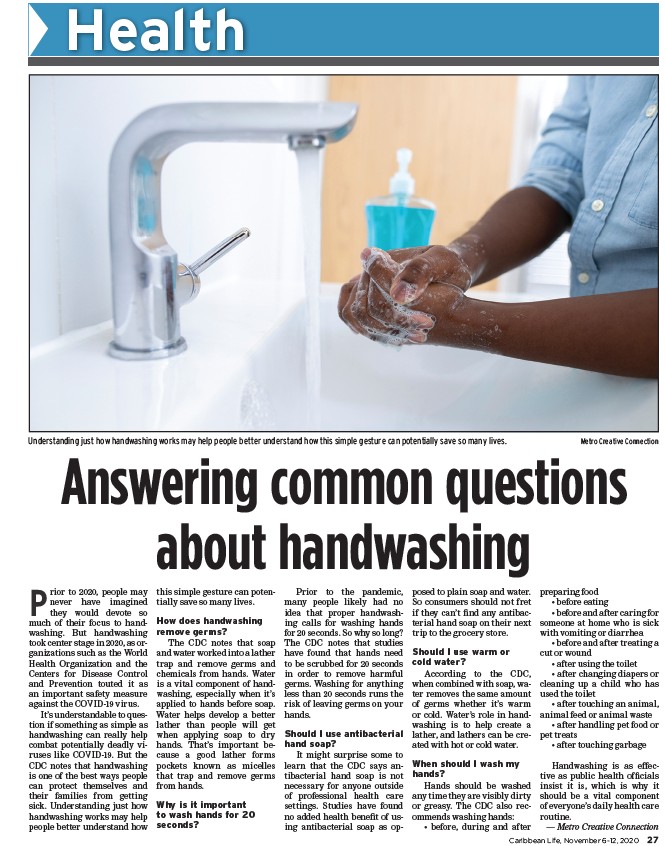
Understanding just how handwashing works may help people better understand how this simple gesture can potentially save so many lives. Metro Creative Connection
Answering common questions
Caribbean Life, November 6-12, 2020 27
Health
Prior to 2020, people may
never have imagined
they would devote so
much of their focus to handwashing.
But handwashing
took center stage in 2020, as organizations
such as the World
Health Organization and the
Centers for Disease Control
and Prevention touted it as
an important safety measure
against the COVID-19 virus.
It’s understandable to question
if something as simple as
handwashing can really help
combat potentially deadly viruses
like COVID-19. But the
CDC notes that handwashing
is one of the best ways people
can protect themselves and
their families from getting
sick. Understanding just how
handwashing works may help
people better understand how
this simple gesture can potentially
save so many lives.
How does handwashing
remove germs?
The CDC notes that soap
and water worked into a lather
trap and remove germs and
chemicals from hands. Water
is a vital component of handwashing,
especially when it’s
applied to hands before soap.
Water helps develop a better
lather than people will get
when applying soap to dry
hands. That’s important because
a good lather forms
pockets known as micelles
that trap and remove germs
from hands.
Why is it important
to wash hands for 20
seconds?
Prior to the pandemic,
many people likely had no
idea that proper handwashing
calls for washing hands
for 20 seconds. So why so long?
The CDC notes that studies
have found that hands need
to be scrubbed for 20 seconds
in order to remove harmful
germs. Washing for anything
less than 20 seconds runs the
risk of leaving germs on your
hands.
Should I use antibacterial
hand soap?
It might surprise some to
learn that the CDC says antibacterial
hand soap is not
necessary for anyone outside
of professional health care
settings. Studies have found
no added health benefi t of using
antibacterial soap as opposed
to plain soap and water.
So consumers should not fret
if they can’t fi nd any antibacterial
hand soap on their next
trip to the grocery store.
Should I use warm or
cold water?
According to the CDC,
when combined with soap, water
removes the same amount
of germs whether it’s warm
or cold. Water’s role in handwashing
is to help create a
lather, and lathers can be created
with hot or cold water.
When should I wash my
hands?
Hands should be washed
any time they are visibly dirty
or greasy. The CDC also recommends
washing hands:
• before, during and after
preparing food
• before eating
• before and after caring for
someone at home who is sick
with vomiting or diarrhea
• before and after treating a
cut or wound
• after using the toilet
• after changing diapers or
cleaning up a child who has
used the toilet
• after touching an animal,
animal feed or animal waste
• after handling pet food or
pet treats
• after touching garbage
Handwashing is as effective
as public health offi cials
insist it is, which is why it
should be a vital component
of everyone’s daily health care
routine.
— Metro Creative Connection
about handwashing